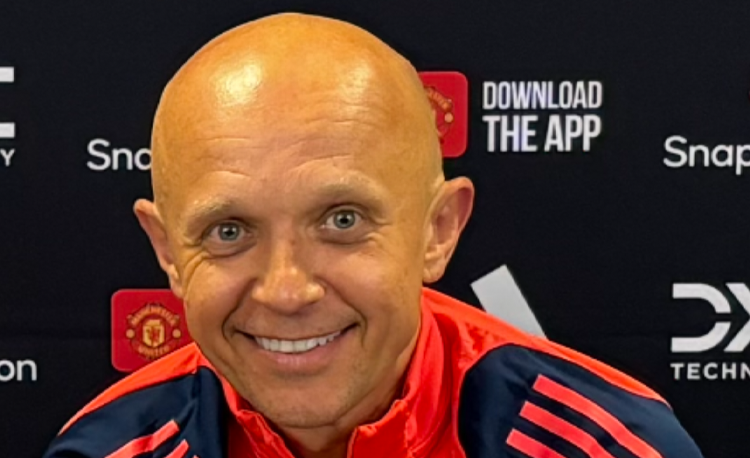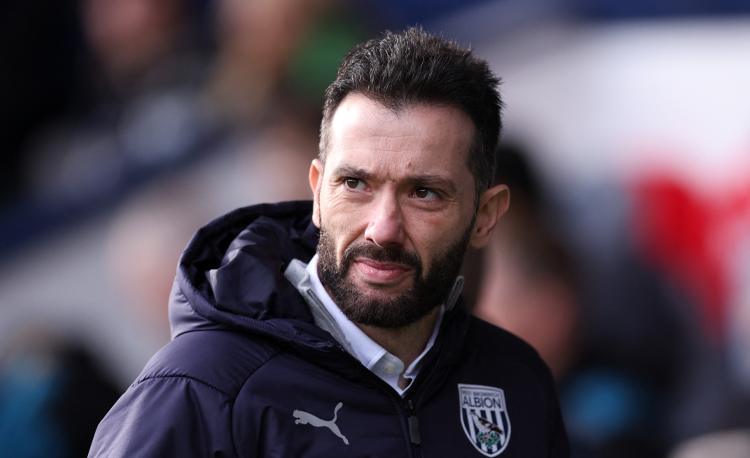You are viewing 1 of your 1 free articles
Transition from defence to attack
The idea behind this session is to run drills that manufacture situations similar to those that occur during a real match. This makes players more familiar with the situations and encourages them to face these phases of the game with more confidence and greater experience.
| Area | Up to two thirds of pitch |
| Equipment | Balls, bibs, cones, 2 full size goals |
| No. of Players | 10 players + 2 goalkeepers |
| Session Time |
Counter-attacking drill: 20mins Counter-attacking game: 20mins 11v11 game: 30mins |
The session is about transitions. It particularly focuses on the quick transition from defence to attack, which is probably one of the most common ways to create chances in football.
The idea behind this session is to run drills that manufacture situations similar to those that occur during a real match. This makes players more familiar with the situations and encourages them to face these phases of the game with more confidence and greater experience.
Usually we would run this type of session three days before a match. It is quite demanding and it’s not only used for its tactical content, as it also gets players to cover distances at high speed. The performance department would guide the coaching staff in this matter, suggesting spaces, distances and numbers so we can not only work on the creativity of the players but also their conditioning.
We could run this session as part of our weekly plan, or we might employ it if we were due to face a possession-based team that uses full backs to push up a lot on the ball; in that instance we want the players to recognise this quickly and counter-attack where the opponent might leave spaces.
What do I get the players to do?
Counter-attacking drill
We set up a playing area of 55x66 yards on two-thirds of a pitch with a goal and a goalkeeper at one end in their usual position. We mark a line 25 yards out from the goal. We’re using 10 outfield players split evenly into a blue attacking team and a red defending team. The attacking team is made up of a striker, two wingers, a centre midfielder and a defensive midfielder. The defending team is made up of a back four and a defensive midfielder, plus the goalkeeper.
Two of the defending team’s centre backs and the attacking team’s striker start behind the byline. The remaining members of the defending team start in the opposition’s half, at least two yards beyond their nearest opponents. The attacking team’s wingers start on the halfway line and the central midfielder starts in the centre circle with the ball, as if the team had just won possession in the centre of the pitch. What we’re doing is eliminating the part of the transition where the attacking team recovers the ball and we create a situation that allows them to start with a temporary superiority; they have a 5v2 overload when the drill begins.
On the coach’s call play starts with the blue striker running from the byline into the midfield ready to collect a pass from the centre midfielder. He is chased by the red two centre backs. As soon as the striker has passed the white line, the midfielder can play the ball to him, as shown [1a].
1a
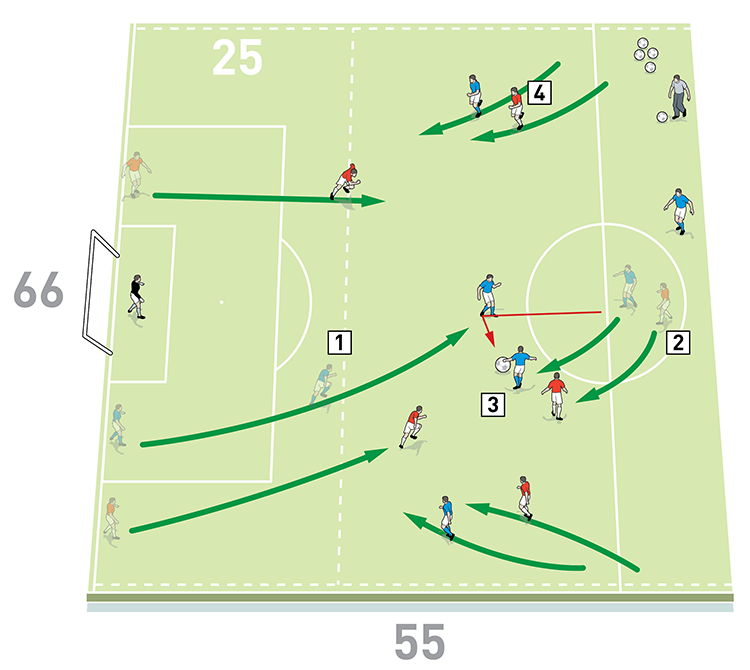
2. The three remaining reds start in the opposition’s half, at least two yards beyond their nearest opponents. It’s as if the red full backs have been caught out while pushing up the pitch
3. As soon as the blue striker has passed the white line, the blue central midfielder can pass to him and they combine to start an attack on the goal
4. The three reds in the opposition half must try to recover to help the two red central defenders
The counter-attack is now on, with the striker and the midfielder combining to work the ball out to the wingers, who use the space in front of them to help create a goal scoring chance, as shown [1b]. The three defenders caught out in the opposition half must try to recover in time to help the two central defenders. If the attackers are not quick enough, it will give the defenders time to recover and reorganise, making it 5v5. Consequently, it will be more difficult to create a scoring chance, so the attacking team must react sharply and attack with pace.
1b
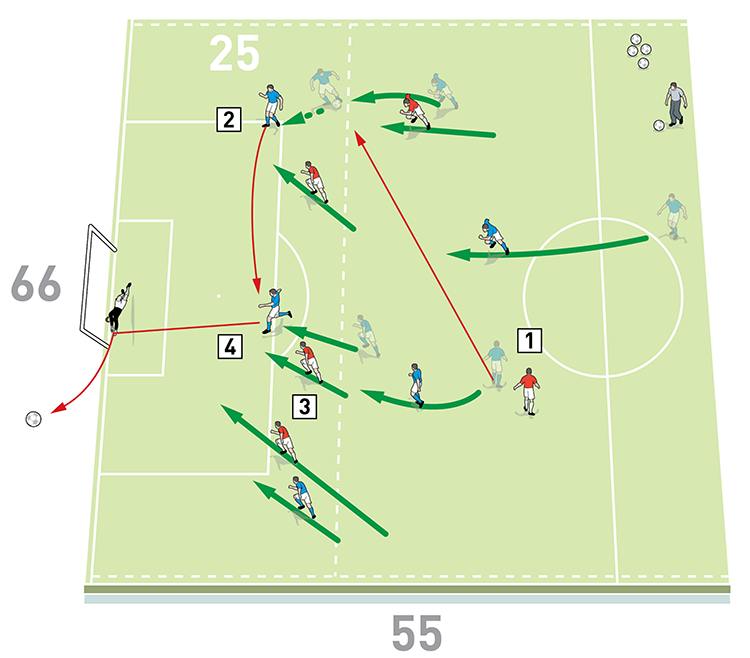
2. The blue wingers use the space in front of them to help create a goal scoring chance
3. The blues counter-attack with a 5v2 overload, but if they are not quick enough it will give the red defenders time to recover
4. Here the blue striker who started the move now receives a cross from the winger and finishes
As soon as the first attack is over, the red defending team quickly reshapes into a back four with a defensive midfielder, and all the blue attackers except the striker must retreat beyond the white line. The coach plays a ball to the attacking team’s defensive midfielder, who combines with the central midfielder to launch a second attack, as shown [1c]. However, this time it will be harder for the attackers to find a free man as the defence is more organised and it’s a 5v5 counter-attack.
1c
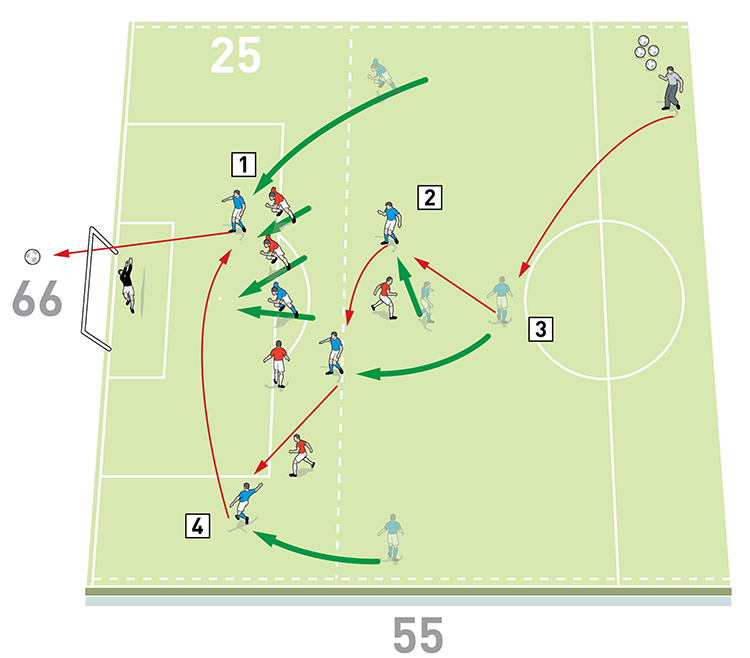
2. All the blue attackers except the striker retreat beyond the white line ready for the second attack
3. The coach plays a ball to the attacking team’s defensive midfielder, who combines with the other midfielder to find the winger and launch another attack
4. It’s a 5v5 attack and the blue attackers must work quickly to exploit any spaces and find the free man because the defence is more organised
We play this for 20 minutes.
Counter-attacking game
We set up an area of 70x50 yards between the penalty boxes of a normal pitch, with a goal and a goalkeeper positioned at each end. We’re using 10 outfield players split evenly into two teams. The game is directional and each team has a pair of players waiting to the sides of each goal. The teams also have one winger each and they are positioned on opposite wings.
The goalkeeper signals the start of play by passing the ball out, as shown [2a]. This is the trigger for all the players behind the byline at both ends to move forwards. The possession team must quickly launch an attack and try to score past the opposition keeper, using the support of their one winger to create a goal scoring chance if needed, as shown [2b].
2a

2. As soon as the ball is live, the players behind the byline at the other end can move forward too
3. The red possession player dribbles out of defence and launches a quick attack on the opposite goal
4. The blues must try to close the attackers down but the reds manage to get their one winger on the ball in plenty of space
2b
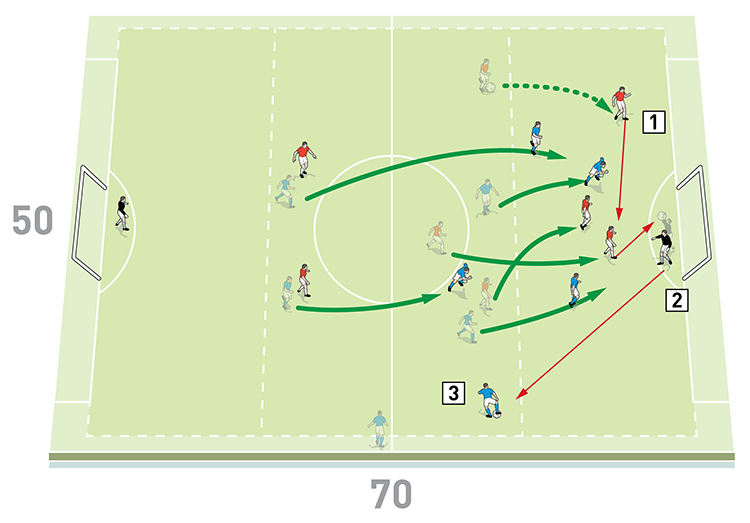
2. The keeper saves and the reds lose possession
3. The blue winger receives the ball from the keeper and the blues make the transition from defence to attack. They must now react quicker than the reds
As it’s a directional game, there is always the possibility that the possession team loses the ball and if the opposition gains possession, they must counter-attack quickly, as shown [2c]. This means that the attacking team must not only be aware of their forward options, but they must also react with speed to recover the ball quickly to prevent their opponents scoring on the counter-attack.
2c
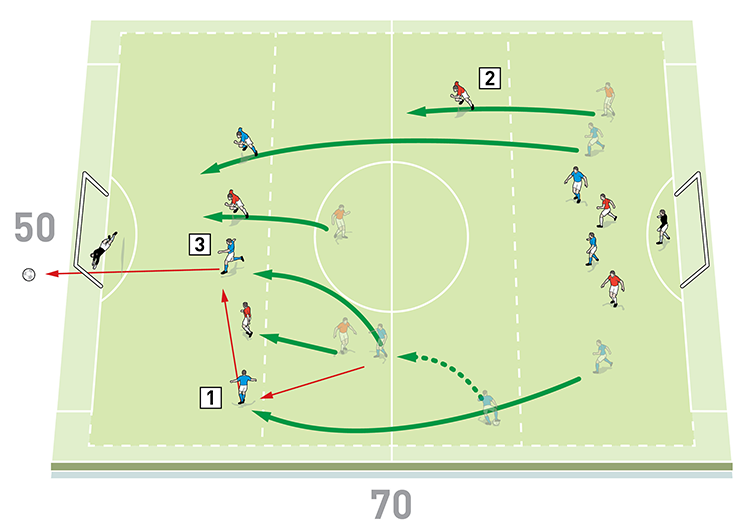
2. The reds have been caught out by the transition and struggle to recover
3. The blue winger makes a central run into space and scores
When the ball goes out of play, reset to the starting positions and begin again in the same way. We play for 20 minutes.
11v11 game
The session is finished with an 11v11 game [not shown] where the message to exploit certain areas is reinforced. We also encourage the team to make quick attacks as soon as they recover the ball. We play two 15-minute games.
How would I put this in a game situation?
Any moment that a team is in a defensive phase is when this type of situation can arise, but really we want our players to execute the transition from defence to attack when they are in a low block and the opposition loses possession in our own half.
What are the key things to look for?
In these activities, speed of thought is key and we want to see players making rapid decisions; they must quickly find where the best possibilities are. When the possession player is running towards the goal with the ball, we want to see support players making runs to attract the attention of the opposition in order to help the ball carrier decide what the best options are, depending on how the defensive line moves.
What are the typical mistakes players might make and how do I avoid them?
At this level, most of the time it is about choosing a better option rather than making mistakes – and this is more difficult to identify. Players don’t want to make mistakes, so it is good to understand that. Instead of finding fault, we try to understand why they choose the option they took and we try to make them see that a better option probably exists.
Related Files
Editor's Picks
Using the goalkeeper in build-up play
Pressing principles
Intensive boxes drill with goals
Penetrating the final third
Creating and finishing
My philosophy
Pressing initiation
Compact team movement
Defensive organisation
Coaches' Testimonials

Alan Pardew

Arsène Wenger

Brendan Rodgers

Carlos Carvalhal

José Mourinho

Jürgen Klopp

Pep Guardiola

Roy Hodgson

Sir Alex Ferguson

Steven Gerrard
Coaches' Testimonials

Gerald Kearney, Downtown Las Vegas Soccer Club

Paul Butler, Florida, USA

Rick Shields, Springboro, USA

Tony Green, Pierrefonds Titans, Quebec, Canada
Join the world's leading coaches and managers and discover for yourself one of the best kept secrets in coaching. No other training tool on the planet is written or read by the calibre of names you’ll find in Elite Soccer.
In a recent survey 92% of subscribers said Elite Soccer makes them more confident, 89% said it makes them a more effective coach and 91% said it makes them more inspired.
Get Monthly Inspiration
All the latest techniques and approaches
Since 2010 Elite Soccer has given subscribers exclusive insight into the training ground practices of the world’s best coaches. Published in partnership with the League Managers Association we have unparalleled access to the leading lights in the English leagues, as well as a host of international managers.
Elite Soccer exclusively features sessions written by the coaches themselves. There are no observed sessions and no sessions “in the style of”, just first-hand advice delivered direct to you from the coach.





